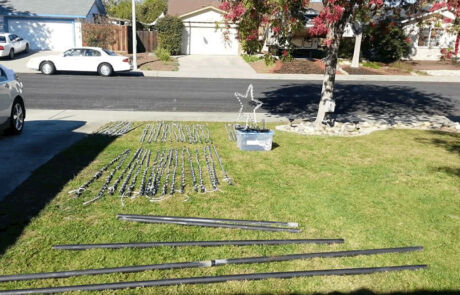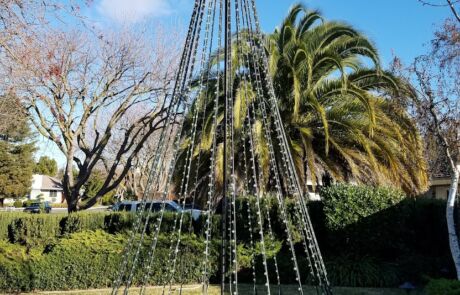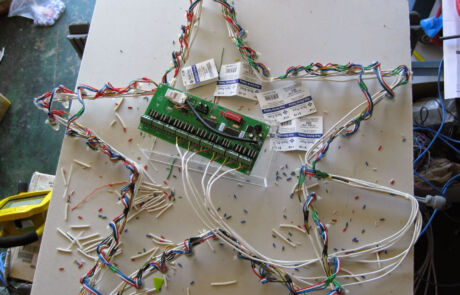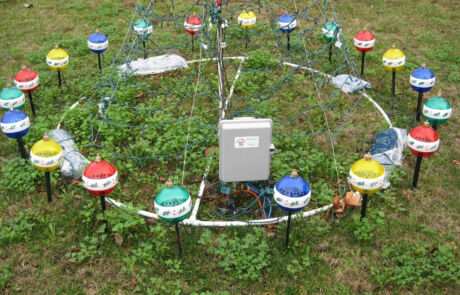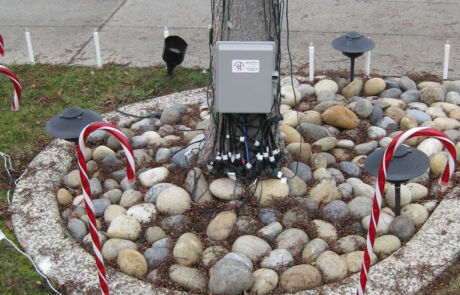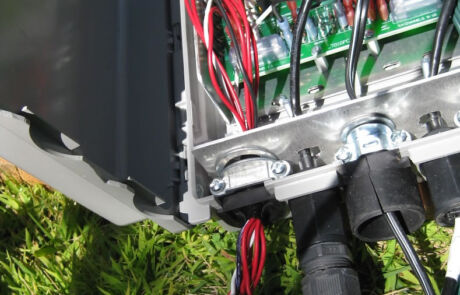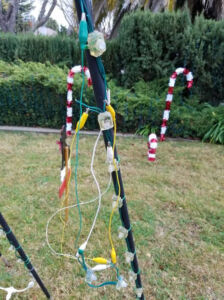Bluebonnet Lights – The Technical Papers
Setup
The wiring starts in October (for Halloween) and takes about 4 days (not full days). Much of the same wiring is used for Christmas.
Christmas setup is about setting up lights and props, as the wiring is basically already in place since Halloween.
Each neighbor owns and stores their own equipment, including the controllers and the lights. Everyone agrees to install and connect their lights before the show starts in November, and to allow one Master Show Player to run the entire show for all the families participating in the show.
Testing
Checking the light setup and tuning/synchronizing the music to the lights is done pretty quickly. Most of the time, it is just a bit of fine-tuning.
We can get quite creative when something goes wrong right before a show. After all, the show must go on -even if we have to rig some pixels with alligator clips!
Synchronize
All the participating neighbors’ lights are synchronized and controlled wirelessly from a single Bluebonnet Lights Master Controller.
We use hardware and software, designed specifically for this purpose, from a company named Light-O-Rama. Part of the software is the Sequencer, which is the software that is used to choreograph the lights to the music. The other part of the software is the show player, which plays the sequences. The show player runs on a Windows workstation, and automatically starts the show on schedule. Most of the lights are connected with USB devices that send the signals to “controllers” over cat5 cable. Most of the controllers are AC controllers that have 16 electrical sockets, each of which is connected to an ordinary Christmas light string. We have 16 of these AC controllers in our show, usually located close to the lights that they control. If you multiply the 16 controllers by the 16 channels they each control, you will find over 250 “channels”.
However, these are not all the channels. We also have some RGB channels, including floodlights, strips, and bulbs, each of which can be any of a million different colors.
Finally, we have the pixel tree, which contains 1,200 pixels, each of which can be controlled individually. This requires a separate connection, using Ethernet from the computer’s network card.
The houses across the street are connected using a wireless link from Light-O-Rama that connects to the cable that goes to the controllers and the USB adapter on the computer.
Broadcasting Music
We use a low-power FM transmitter, permitted under FCC part 15 rules to transmit the music from the Master Show Player to speakers located on the grounds.
Energy Consumption
The show uses much less power than it appears, such that we can’t even see a change in our December electric bill. There are 2 reasons for this:
1. Most of the lights are LED, which use very little power; but most importantly
2. Because the show is animated and not static, each light is on for only a fraction of the time, and when it is on, it is often dimmed. A light that is flashing to the beat, even if it’s flashing several times a second, uses much less electricity than a light that is turned on for the whole night.
An Example of How Long it took to make, Synchronize and Test a New Element for the Light Show
The very first thing I built for the show was the candlesticks. While they look pretty simple, they started out as 6 boxes that each contained a string of 10 candlesticks. However, each string was wired together, but I wanted the ability to “chase” the candlesticks and make them flicker in a way that makes them look independent. It was decided to wire them in 4 channels, which when laid out, would have channel numbers 1, 2, 3, 4, 1, 2, 3, 4, etc. In order to do this, each candlestick had to be cut from the string, and wires attached. This required over 200 splices, which was done over a period of several weeks starting early in the year.
Another big project, done in 2015, was the pixel tree, which was modeled after one I saw at a friend’s display. He gave me the plans, which required parts to be ordered from China and also a bunch of hardware. There was cutting, wiring, painting, using about 4 people over several weekends. I didn’t keep track of the actual time it took.

